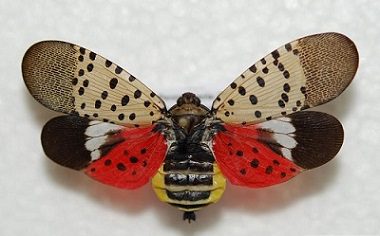
Over and over at various village meetings on the North Shore the Spotted Lanternfly has grabbed a spot in the conversation. Now, the Town of North Hempstead is urging residents to be watchful and report the invasive insect to the New York State Department of Environmental Conservation.
The Spotted Lanternfly is known for its distinctive appearance featuring bright red wings and polka dots. It is also known for its potential for devastation within forests and plant life. Maple, walnut, fruit trees, and a diverse array of plants are affected by the invasive species.
Jacob Leeser, an extension support at New York State Integrated Pest Management, emphasized the necessity of swift action to curb the invasive species. While the Spotted Lanternfly doesn’t bite or sting and is nontoxic, its detrimental effects stem from its feeding habits. By extracting sap from stems and branches, the insect triggers a series of damaging events. The honeydew it produces fosters the growth of harmful mold, a factor contributing to the eventual demise of the affected plant.
Leeser said the Spotted Lanternfly is not going anywhere for a while, despite only entering New York recently. “New Yorkers are going to have to become acquainted with this,” he said, “but they’re going to be around at least for a few years. There’s starting to be some evidence that these really high infestation levels that we’re seeing in Staten Island and other parts of New York City this year are not going to be sustained.”
Originating from mainland China, where it isn’t considered a pest, the Spotted Lanternfly found its invasive potential unlocked in Korea, and it’s likely that it was inadvertently imported to America from there. Leeser said increased travel and development could have contributed to its importation.
Invasive species usually die, but “both spotted lantern fly and the Tree of Heaven, Ailanthus, really thrive in disturbed environments,” he said.
The past eight years have witnessed a surge in research focused on the Spotted Lanternfly since the pest’s introduction to southeast Pennsylvania in 2014. It’s suspected that insect egg masses were unnoticed on shipments and made their way to America, potentially on wooden pallets.
Pennsylvania’s grape industry, in particular, felt the impact of the invasive species, earning the bug the label of “grape pest.” Leeser said Long Island vineyards might be affected in the coming weeks and “definitely will change in the coming years.”
Research conducted primarily by Penn State and coordinated by Cornell has been pivotal in understanding and addressing the issue.
Acknowledging the absence of natural predators, Leeser cautioned against the unchecked growth of the Spotted Lanternfly population. Businesses with outdoor seating, including vineyards, could face substantial challenges due to the swarms of these insects. And fallen trees pose a potential risk to person and property.
Cornell is developing a biopesticide that uses naturally occurring fungi that can effectively eliminate the Spotted Lanternfly. Additionally, the hope of scientists is that native predators will eat the invasive bug as it integrates into the ecosystem.
“On one hand, don’t panic,” Leeser said. “Don’t overreact. On the other hand, don’t move it, you know, New Yorkers, Long Islanders included, put up with a lot of a lot of changes in their environment, a lot of challenges. This is going to be one more and if we can let’s let’s hold the line and not let the Lanternfly spread.”
Residents are urged to inspect their trees, vehicles, firewood, and outdoor furniture for egg masses and destroy the masses and insects. Egg masses can be destroyed by scraping them into a bucket of hot, soapy water or into alcohol-based hand sanitizer.
For those who encounter the Spotted Lanternfly, the town is asking residents to “please take a photo of the insect, egg masses, or the infestation and email it to spottedlanternfly@agriculture.ny.gov or call the DEC’s Forest Health information line at 1-866-640-0652.”
To learn more about the Spotted Lanternfly and its prevention, visit www.dec.ny.gov/animals/113303.html.







It’s not necessary to “take a photo of the insect, egg masses, or the infestation and email it to spottedlanternfly@agriculture.ny.gov or call the DEC’s Forest Health information line at 1-866-640-0652.”
They’re aware of the infestation in Nassau